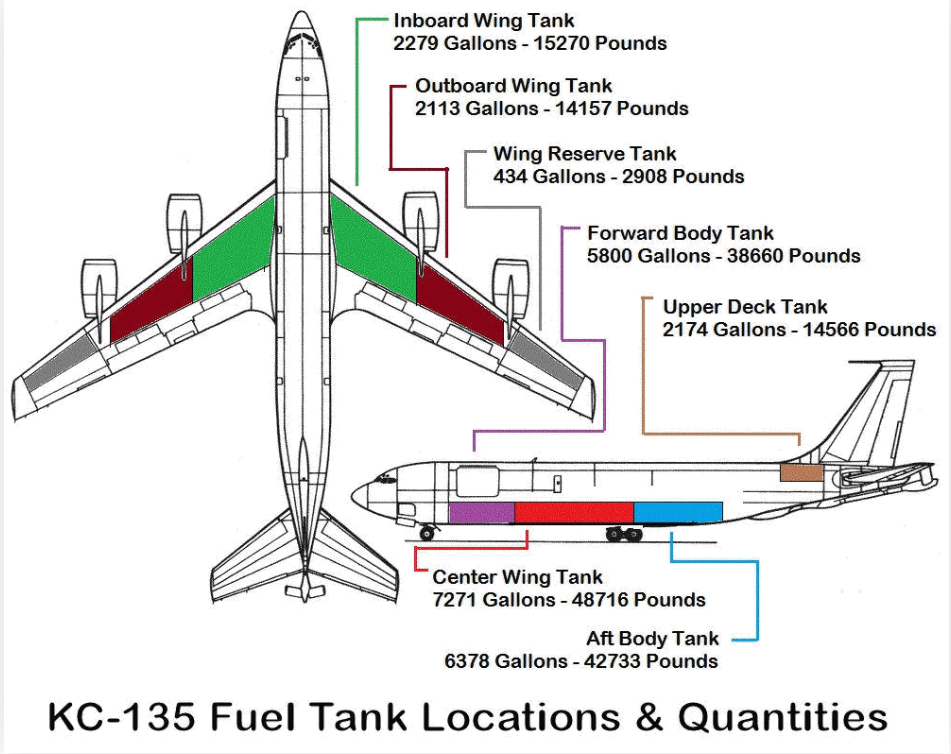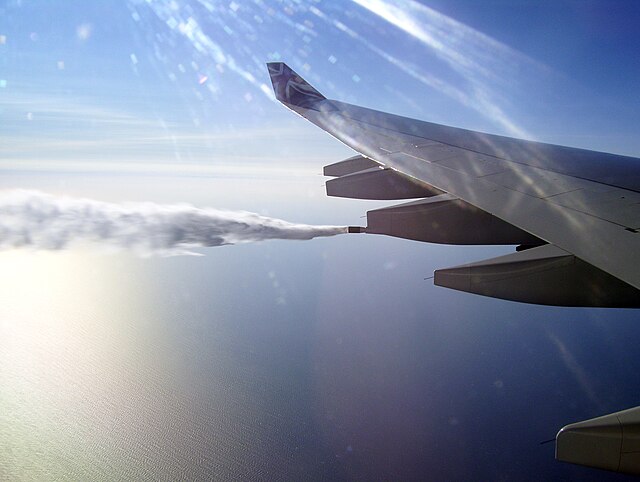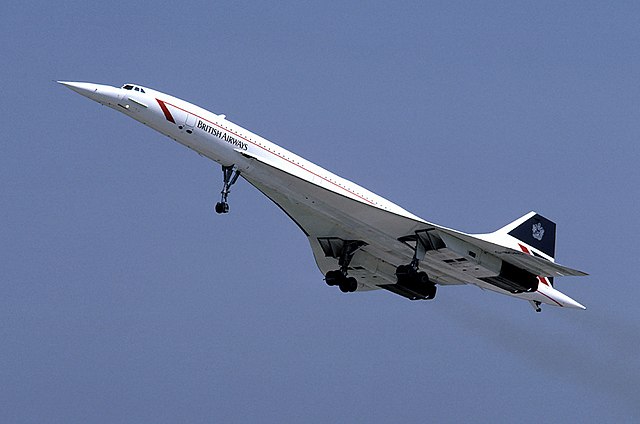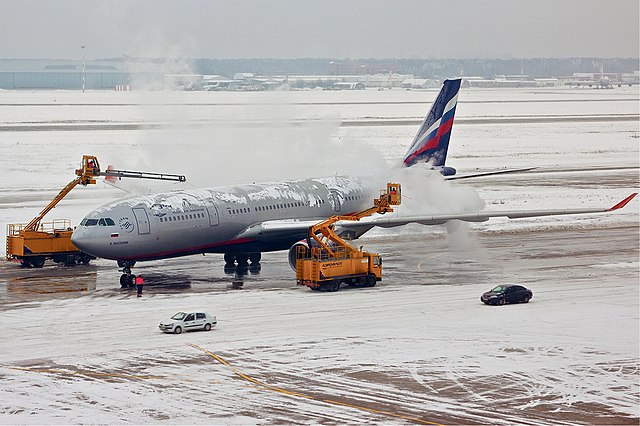
Trash can filled with waste
Air transport plays a vital role in today’s globalized world, but the operations associated with it hide an environmental cost. Sources of water pollution by airplanes that this report tries to explain include de-icing fluids, fuel spills, and waste disposal. We will examine the impact that they have on various marine lives and drinking water which suggests the need to empower the laws on the same so as to enhance environmentally friendly practices. Some of the most promising solutions suggested in this article include ice-free aircraft recycling that is environmentally friendly. This proves that the sector has great potential to transform towards a greener future.
Various types of waste produced by the aviation industry:
Fuel tankering:
Fuel tankering is when an aircraft carries excessive fuel internationally. This strategy aims to reduce or stop the refilling of the fuel tank. Airports are notorious for selling overpriced goods, and the same goes for fuel. Airlines try not to refill their tanks at the airport but rather at other destinations for lower prices. Fuel accounts for 17–25% of airlines’ operational costs. Therefore, it makes sense for them to seek any possible savings. While it saves money, fuel tinkering comes at an environmental cost. The aircraft tends to carry more fuel than is necessary on board. This means the aircraft needs to carry additional weight. This directly relates to the aircraft using more fuel. Using more fuel equals more combustion and correlates with more CO2 (a potent greenhouse gas contributing to climate change) being released.
Airlines are the estimated sources of 900,000 metric tons of CO2 flying in the air because they haul fuel around in the event. Such CO2 release is equivalent to that of a middle city with a population of over 100,000 individuals or 3,800 round trips across the Atlantic without return. This is rather worrisome given today’s work being done to make aviation more environmentally friendly. However, there is some good news; the world has recently started to turn to sustainable aviation fuels (SAF). Another reason for the increased air transportation sustainability is that several airports are trying to make it carbon-neutral.
A BBC investigation revealed a troubling example: a recent British Airways flight carried nearly three extra tons of fuel. This unnecessary fuel resulted in an additional 600 kg of CO2 emissions. To illustrate the impact, this is the same amount of CO2 released by driving a car for almost 1,500 miles. According to the results of a study conducted by Eurocontrol, the European air traffic control agency, more than 20% of flights over Europe are fuel tankering optimized. This measure is being adopted on almost a third of flights within the European Civil Aviation Conference (ECAC) region. Flights carried full fuel tankering on arrival in 15% of cases. Also, 15% are half-fueling, flying with less fuel than needed to refuel at their destination and again a little over the top.

The majority of the fuel is stored in four “body tanks” that hold over 144,000 pounds of fuel. In contrast, the F-15E strike fighter, when equipped with conformal fuel tanks and three drop tanks, can carry a maximum of only 35,550 pounds of fuel.
Fuel Dumping
In some emergencies, airplanes can release fuel in a controlled manner, a process known as fuel dumping or fuel jettison. In case of an emergency, airplanes may even dump fuel to make landings more safe. Many transport category aircraft are certified with both takeoff and landing weights higher than the maximum zero fuel weight. Aircraft will be provided with a fuel dumping system if the aircraft otherwise fails backup engine-out climb requirements at maximum takeoff weight or exceeds ‘over-weight’ landing design limits. This decreases the weight of the aircraft, thus improving its chances for a safe landing. Although far from perfect, thousands of gallons are dumped regularly with a strict procedure at a specific altitude inferred by calculations
Fuel-disposal systems shall meet the following requirements: The average rate of fuel jettisoning must not be less than 1 percent of maximum weight per minute; however, it is not required that the total time to jettison, from maximum takeoff to maximum landing weight, be less than 10 minutes. Fuel evaporates long before hitting the ground, based on these figures. This means that when the fuel is released from aircraft by dropping it at low altitudes in the troposphere, a narrow band of elevated hydrocarbons will enlarge over any area where many aircraft are using fast-dissipating jet engines. However, the fuel in contact with the ground can lead to detrimental environmental impacts like crop injury and water pollution (Clewell & Good 1980; Good & Clewell 1980).
A lawsuit has been filed against Delta Airlines after a plane dumped fuel on Pioneer High School in Los Angeles. This follows similar legal action taken by teachers last month. The controversy centers on the altitude at which the fuel was dumped. Normally, pilots aim to jettison fuel at high altitudes (over 5,000 feet) to allow it to evaporate before reaching the ground. Additionally, they target remote areas to minimize the impact on people and infrastructure. While no serious injuries occurred in this incident, some minor ones were reported. The lingering concern is the fuel’s toxic smell, which has heightened anxieties due to the neighborhood’s history of industrial contamination.
Key takeaways:
- An uncommon procedure: Fuel dumping, also called fuel jettisoning, is a rare technique used only in emergencies or specific scenarios. Airlines prefer to store the fuel on board for later use at 35,000 feet.
- Dumping fuel to lower the weight so they can make a landing if something breaks.
- Unlike oil, which may contaminate the earth below and water supplies by sinking beneath topsoil or into aquifers depending on where the spill occurs again, fuel is being dumped at high altitudes; this fact alone means that most (but probably not all practice) will result in evaporation of a large portion before it hits the ground.
- Controlled for Safety: When fuel dumping is necessary, aviation authorities enforce strict regulations to ensure the act of burning off excess kerosene is carried out safely and responsibly designed to minimize environmental impact.

Airplane “dumping” its fuel.
General Co2 emissions
Aviation accounts for around 2 percent of total human-induced CO2 emissions (915 metric tons in 2019). This compares favorably with the CO2 cost of shipping but is perhaps not so easy to appreciate when compared cooler by cooler if we ignore another realm (computers and tablets, actually accessing all this internet). In 2017, Bitcoin mining, for instance, emitted as much CO2 into the atmosphere (69 Mt) from ongoing operations across the globe. International aviation (not included in national CO2) accounts for around 1.3% of the total, i.e., much more than that of Indonesia or Canada. If aviation were a country, it would be ranked as the 11th or 12th largest emitter on earth.
The good news is that airlines are becoming ever more efficient, in the sense of how much fuel they burn to transport one passenger from A to B. Between 2005 and 2017, there was a remarkable fall of no less than 24% in fuel burn per passenger. The bad news? The growth of air travel. Passengers traveled a lot further than before; the average passenger flying distance covered was 60% higher in 2017 compared to what he had flown in 2005. But these increases in air traffic are nevertheless so explosive that they reverse the reduced fuel consumption, inhibiting those gains. In the EU, too, aviation plays a substantial role. This part relates to direct CO2 emissions from flights, which made up 3.8% of all EU greenhouse gas production in 2017.
Drilling down by mode of transport shows that the aviation sector, which represents 13.9% of CO2 from this subsector in terms of total production (second only to the road), as you can see below, Air travel accounts for a significant portion of the emissions that contribute to climate change. The increase was higher than from road, rail, or shipping but accounted for only 2% of global energy-related CO2 in 2020. Business-as-usual, pre-pandemic emissions levels could come roaring back when we start traveling again—if they haven’t already—almost 800 million metric tons of CO2 are estimated to be released in flying this year alone, or about four-fifths of what was put into the air by airlines just a few years ago.
Food waste
Airline companies waste too much food. It is estimated that about 1.14 million tons of airplane meals were wasted in 2017 alone. Some airlines fight the problem using artificial intelligence. This intelligent technology analyzes what passengers eat and what gets tossed. Armed with data, carriers can load up fewer unpopular items and more of their favorites. It’s a clever approach that cuts food waste by up to 35%, reduces loads for airlines, and might just let them offer passenger-preferred meal choices.
Had it not been for this factor, the quality of food airlines have been trying to improve in recent years. With more and more people developing concerns over their health, more airlines are now expanding their range of meals offered in-flight to be less penetrative to the health of the travelers. Since passengers are psychologically always concerned about their feeding, while at the same time, the airlines stand to gain by reducing the production of food that normally has a very short shelf life and is normally thrown away, there is a big possibility by implementing this method, the food waste in this big world could be greatly reduced. Airlines are committed to sustainability; that is why cost-saving measures regarded food waste, substitution of plastics for paper and compostable materials, and improvement of the recycling system are priorities. Besides, measures to keep the interiors of the planes extremely clean are also being put in place to allow passengers to eat their in-flight meals without contracting COVID-19.
One crucial aspect that should be disabled in the operations of airports is food waste. It is, after all, undertaken, as in the case of Santiago International Airport, where 220 million metric tons of food go to waste annually in Latin America, which initiated a campaign against wastage of food by selling it at reduced prices on a mobile app while approaching its expiry date. Denver International Airport, US, where 40 percent goes to waste annually, joined forces with the non-profit organization “We Don’t Waste” to redistribute food items.
Combating food waste in the sky:
- To achieve their ambitious target, Emirates Flight Cooking (EKFC) has partnered with Winnow to create a high-tech system that uses artificial intelligence and machine learning to manage food waste.
- JAL fights food waste with two options:
- Passenger Choice: Skip pre-ordered meals on select flights to reduce preparation.
- Composting Leftovers: JAL Royal Catering now composts leftovers, turning waste into fertilizer.
Other types of cabin waste
On average, it emerged that every passenger produces about 1.43 kilograms of cabin waste on any flight, both short- and long-haul international. In this bulk, untouched food and drink alone comprise 23 percent, while 17% comprise recyclable materials like plastic bottles and newspapers. These findings underline the powerful effect that food waste and recyclable materials have on cabin waste within flights, opening up opportunities for better waste handling and recycling within the aviation industry. Aviation waste reaches beyond items like food and beverages that are left over on aircraft. Here’s a breakdown of some other categories:
Cabin Waste: Cabin waste consists of all wastes produced by the passengers within a flight and these wastes are disposed through the aircraft. Some of these include; used tissues, plastic cups or cans containing soft drinks or beer, newspapers or magazines, amenities such as eye masks or slippers in an amenity kit, or sanitary waste such as soiled diapers or care products. This type of waste plays a major role in onboard waste and therefore influences in-flight waste management plans and measures.
Toilet Waste: Waste is produced solely from airplane restrooms. These include baby diapers, sanitation products, and all sorts of things wet and flushed down the porcelain conveniences or thrown into lavatories. Specialized disposal methods may prove necessary for handling hazardous or bio-contaminated materials.
Reading Material Waste: Newspapers, magazines, and other waste resulting from the reading materials provided to passengers. This adds to paper waste, which can be recycled, but collection and processing facilities need to be available.
In-flight service waste: Garbage that results from services offered in flight is significantly a result of flight attendants. Some of them include plastic forks, spoons, knives, plastic napkins, beverage stirrers, and other food and beverage serving disposable types of equipment. In many cases, single-use plastics need disposal after use or where applicable: recycling.
Ground Handling Waste: Waste is produced by ground operations at both airports of departure and arrival. Examples of boxes included are those for catering supplies, food delivery, maintenance equipment, and cleaning materials servicing aircraft. This calls for efficient management of waste that results from vast activities in airport environments.
About 85 % of an aircraft can be recycled, and the rest 15% is wasted.
Airplanes, once they reach the end of their usable lives and, for whatever reason, are decommissioned, do not just disappear. They aren’t bound for the kind of cemetery you’re likely thinking of, though; they find a home in an aircraft boneyard. Thousands of planes call these massive storage facilities home for the final time, most of which are established in arid deserts. However, this isn’t a collection of rusty old airplanes; it’s an invaluable recycling facility for the aviation sector. The typical junkyard is a treasure trove of spare parts and excess stock. Engines, landing gear, and flight controls live on. Engines in particular are in high demand and can even be reutilized on different aircraft. This not only saves money for airlines but also diverts perfectly good components from landfills.
The worldwide shredded aircraft marketplace is also on the upward thrust and will exceed $6 billion by 2022. Before any parting happens, though, a vital step protect the environment. Organizations such as the Aircraft Fleet Recycling Association (AFRA) carefully drain and properly dispose of hazardous fluids like lubricants and batteries. Engines dominate a thriving aftermarket for aircraft components. Brand-new or factory-refurbished parts are also used because they can be legally more affordable for airlines and repair shops. This creates even more demand for aircraft boneyards, allowing the planes to be kept in operation longer.
This type of service frequently brings the team to PlaneSnabb’s ‘partners’ in Tucson, a desert oasis for aircraft recycling. The biggest resides at Davis-Monthan in Arizona, and the sprawling 2,600-acre base is home to over 4,400 aircraft. The existence of these boneyards is a testament to the practicality of aviation and provides aging planes with an opportunity for new life in the sky. Albeit not as originally intended, and some have found their way into other entertainment fields.
Noise
The Concorde burst onto the scene 50 years ago, promising a supersonic revolution in air travel. This marvel of engineering boasted incredible speed, but its reign was short-lived. Despite the hype, only 14 Concordes ever carried paying passengers, and the program ended a mere 34 years after its debut. The Concorde wasn’t only quick; it was the fastest of them all. Whereas the crack of sound travels at around 1225 km/h (761 mph), the Concorde cruised at an astonishing speed of 2,200 km/h. In other words, it could fly from New York to Paris in three and a half hours—about half the time it takes on a standard flight today! That’s also an incredible ten times faster than Charles Lindbergh’s pioneering non-stop transatlantic flight of 1927.
The Concorde ruled unchallenged only briefly; various factors combined to bring its reign to an abrupt end. Though hugely impressive in terms of speed, the supersonic jet turned out to be a double-edged sword. Some reasons are that the missions were so expensive that the price of tickets reached the sky, only limiting the customer base of Concorde. This, along with the unwelcome sonic boom in many airspaces, restricted its flight paths. New York or Bust: These very limitations caused airlines to service exclusively the New York-to-Paris route, further leading to a reduction in profitability. The tragic 2000 crash of an Air France Concorde, caused by an engine failure that killed 123 people, undoubtedly accelerated the retirement of this model in 2003.
Though the Concorde was faster than most commercial aircraft, it also had a loud arrival. Earsplitting loud. Setting more recent records at places like Washington Dulles in 1977 by flying off with a deliriously loud 119.4 decibels. For comparison, a clap of thunder is roughly 120 decibels, and anything over 110 can be painful to your ears. In the future, there will be speed-of-sound aircraft that do not produce this ear-piercing noise, but because the Concorde was so shatteringly loud and had such an enormous sonic plume (meaning everyone in a line behind it would hear it). Acoustic fencing was used at some airports to ameliorate effects on animals. Constructed with sound-absorbing materials, these deflection baffles were built to redirect and absorb the Concorde’s noise pollution which allowed for a quieter environment for nearby critters.
Negative impacts on wildlife and humans due to airplane noise:
- People who live near airports have reported disturbed sleeping schedules as well as cardiovascular diseases and an overall negative impact on their lives.
- Loud airplane noise can mask the sounds made by animals to communicate, find food, and mate which leads to confusion and stress.
- Loud noise can also cause habitat fragmentation of wildlife.

Concorde- A supersonic
Aircraft paint waste
Important Safety Guidelines on the Use of Paint Strippers on Aircraft
Read Before You Strip: Always read the SDS of the specific paint stripping solution used. It specifies which surface is suitable for use, such as aluminum aircraft skin. And which surfaces are unsafe, such as steel, high-strength aluminum, magnesium, rubber, plastic, and composite materials.

D-limonene? No thanks: Be sure to avoid paint strippers that contain D-limonene, as they corrode the aircraft. Freshness is Best: Paint strippers become less effective or dangerous to use if left on the shelf for too long. Therefore, avoid old paint strippers.
SAFETY FIRST: Paint with a maintenance contractor or senior aircraft mechanic. They can be confident that you are using the appropriate steps, procedures, and safety measures to prevent accidents.
Protect your plane (And yourself!): Tape off surfaces that might accidentally come into contact with the paint peeling area.
The days of harsh chemical paint removers are slowly becoming a thing of the past. Fortunately, more eco-friendly options are finding their own in the marketplace and genuinely have several advantages:
Science to the Rescue: The manufacturers of improved solvent formulates, nanotechnology, and paint stripping efficient methods are being witnessed.
Regulations Drive Innovation: Tightened regulatory measures in one country compel manufacturers in the industry to develop other friendly and efficient paint removers.
The Future is Green: With new tools and predictive approaches, a new era of effective paint removal has been brought into existence without harming the environment.
Water pollution due to aircraft de-icing fluid
When planes start their flights and when they also desire to land, they cause the formation of other layers of aerial clouds. A fluid used to remove ice on aircraft, fuel, and lubricants can contaminate water close to the depot. This not only pollutes the seas and hurts sea animals but also the water we consume can be affected. To address this issue, stricter environmental regulations and improved methods for dealing with wastewater must be developed. But knowing how aviation influences water quality is a way of safeguarding seas, rivers, and consequently – people’s wellbeing. In turn, understanding the problem will allow creating the relevant plans for organizing environmentally friendly aviation relations.
Salting fluid has a double effect on airports. Although they help clean the way for planes to take off, they can introduce toxins into nearby bodies of water. These fluids, particularly those with propylene glycol and potassium acetate, are responsible for a significant portion of the organic pollution in airport waterways. The tiniest leaks, however, lead to colossal chaos. Small quantities of these de-icers, if introduced directly into rivers, lakes, or streams, can cause damage. Now, water quality is a very important thing, and they have regulations for that. The onus is on airports to get their act together. This is why airport operators are required to have de-icer management plans (DMPs). These plans detail how pollution will be prevented and how contaminated runoff to the marsh from de-icing activities will be managed. It’s a tough nut to crack. Perhaps the largest environmental challenge confronting airports is how to successfully manage pollution from de-icer operations.

De-icing of airplane
Types of De-icing Fluids Used by Airplanes
Airplanes use four types of de-icing fluids, classified according to stringent SAE International standards, such as:
Type I (Orange): Covers are thin and will last for months of quick removals. Use it whenever you only need to remove a light ice or snow cover from your wheelchair platform. Sprayed hot at high pressure.
Type II (Clear): Similar to Type I but contains thickening agents that make it thicker and better at preventing ice buildup on planes with larger sizes during ground operation. When it goes faster than 50 mph, the model is ineffective. Prefer Type IV instead of declining.
Type III (yellow): an intermediate level of friction and typically used with structures with slower aircraft movements.
Type IV (green): This is the same as Type II, but it lasts longer. Tinted green for better visibility.
Conclusion: Air Travel and Environmental Degradation: Strategies for a Sustainable Future
As connected as our world happens to be, the contribution of the aviation industry can hardly be belittled, but its environmental implications cannot be overlooked either. From CO2 emissions to water and noise pollution, air travel leaves an imprint.
